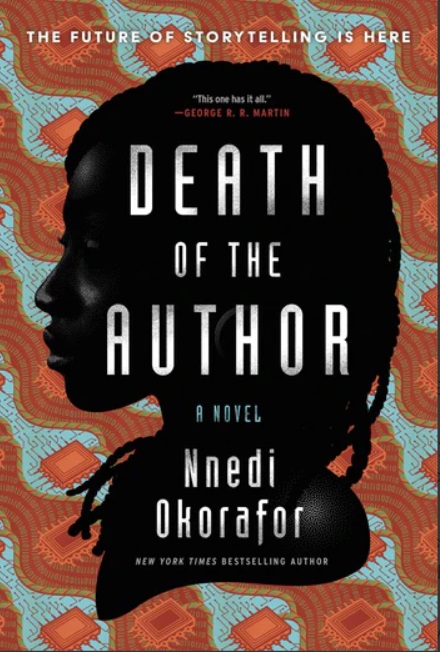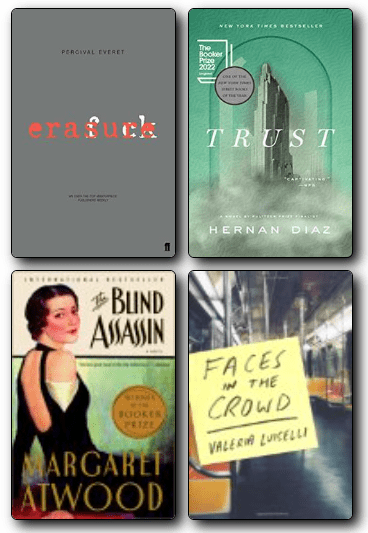Summary | Excerpt | Reviews | Beyond the Book | Read-Alikes | Genres & Themes | Author Bio

A Novel
by Nnedi OkoraforThis article relates to Death of the Author
 Nnedi Okorafor's Death of the Author includes an example of a type of metafiction known as an "embedded narrative"—in other words, the novel contains another novel (in this case a futuristic science fiction narrative) within its pages. This technique has been around for hundreds of years, in works like Shakespeare's Hamlet and A Midsummer Night's Dream (both of which contain plays-within-plays) or One Thousand and One Nights, which consists of a framing story that encapsulates numerous shorter narratives.
Nnedi Okorafor's Death of the Author includes an example of a type of metafiction known as an "embedded narrative"—in other words, the novel contains another novel (in this case a futuristic science fiction narrative) within its pages. This technique has been around for hundreds of years, in works like Shakespeare's Hamlet and A Midsummer Night's Dream (both of which contain plays-within-plays) or One Thousand and One Nights, which consists of a framing story that encapsulates numerous shorter narratives.
In more recent years, contemporary novelists have employed embedded narratives as a way to inform, complicate, or expand their narratives, often using the novel-within-a-novel to interrogate the process of writing and the role of the author, in both playful and serious ways. The term "mise en abyme" (literally "placed into abyss") is sometimes evoked in the context of literary criticism to discuss examples of embedded narratives that illuminate or reflect the "main" or framing narrative in some way. No fewer than eight Booker Prize winners and nominees have employed this technique, which Gazelle Mba likens to a literary Matryoshka doll, the Russian nesting doll that reveals seemingly endless new surprises inside.
Here are just a few notable examples of this technique:
Erasure by Percival Everett
Best known as the basis for the 2023 feature film American Fiction, Everett's 2001 novel includes a novel (We's Lives in Da Ghetto) supposedly written by his protagonist. According to cultural critic Carole V. Bell, the inclusion of this parodic novel is part of what makes the larger narrative complicated and worthy of discussion; as she points out, "mimicking problematic portrayals [in this case, involving stereotypical portraits of Black Americans] involves reproducing them."
Trust by Hernan Diaz
Diaz's 2022 novel, which won the Pulitzer Prize and was longlisted for the Booker Prize, includes four separate documents used to tell the story: a manuscript, a memoir, a diary, and a novel-within-the-novel. Each of these documents is "written" by a different character, and each one prompts the reader to consider the trustworthiness of the storyteller and the "truth."
The Blind Assassin by Margaret Atwood
Atwood's 2000 Booker Prize–winning novel, like Okorafor's novel, involves a blend of literary and science fiction approaches. In Atwood's case, the embedded narrative, also called "The Blind Assassin," was written by the protagonist's deceased sister Laura, and consists of an additional story-within-a-story about the inhabitants of the planet Zycron; published after Laura's untimely death, it became a cult classic. According to Kirkus Reviews, these "two absorbing stories...cast an initially enigmatic, ultimately pitilessly revealing light on each other."
Faces in the Crowd by Valeria Luiselli
Luiselli's debut novel, published in 2012, features a nameless narrator intent on writing a novel; the primary subject of her fiction—the ghost of a man named Gilberto Owen—gradually starts to tell his own story, which includes his observations about Luiselli's protagonist. Like Okorafor's novel, Luiselli's is a bit of a mind-bender, prompting reflection and debate about authorship and the divisions between reality and fiction.
Readers who want to discover other examples of this rich and sometimes surprising technique could also check out Cloud Atlas by David Mitchell; Atonement by Ian McEwan; Loitering with Intent by Muriel Spark; A Tale for the Time Being by Ruth Ozeki; Trust Exercise by Susan Choi; and, for younger readers, Tiger Moon by Antonia Michaelis.
Filed under Reading Lists
![]() This article relates to Death of the Author.
It first ran in the January 15, 2025
issue of BookBrowse Recommends.
This article relates to Death of the Author.
It first ran in the January 15, 2025
issue of BookBrowse Recommends.
Your guide toexceptional books
BookBrowse seeks out and recommends the best in contemporary fiction and nonfiction—books that not only engage and entertain but also deepen our understanding of ourselves and the world around us.